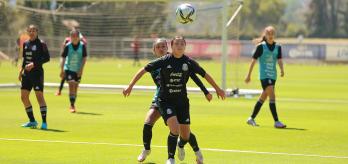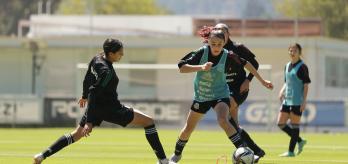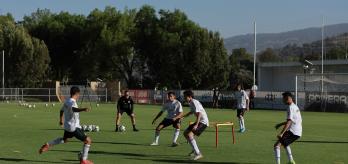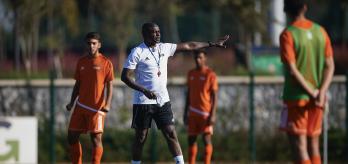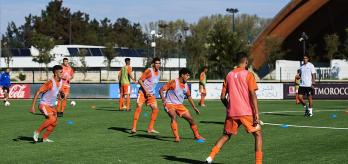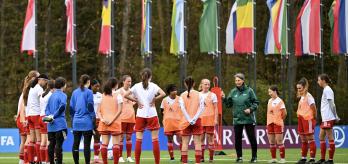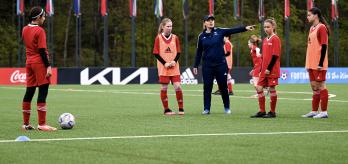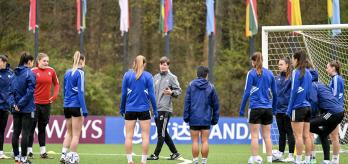Mastering the defending principles enables a team to become more capable in their defending, both in individual terms and as a unit, by applying fundamentals such as the high press and the mid-block, as well as understanding pressing triggers and when to apply them. Organisation, compactness, communication, togetherness, body positioning and denying the opposition are imperative elements when it comes to creating a solid defensive unit.
In this session, Michael Johnson, ex-Derby County and Birmingham City defender and current England U-18 assistant coach, presents some drills and exercises based on defending principles that focus on high pressing and the mid-block. Ultimately progressing towards an 11v11 game, the session begins with 8 attackers taking on 6 defenders in a phase of play that focuses on forwards and midfielders. This then leads into a 2v2/3v2 game that revolves around the centre-backs defending in pairs, followed by a 6v5 game in which the emphasis is on the full-backs, before rounding things off with an 11v11 game. The objective of these drills is to improve players' command of the defending principles, such as structure, containment, rhythm of defending and togetherness when under high pressure and pressing the opposition.
Session overview
-
Part 1: 8v6 phase of play (focus on forwards, midfielders)
-
Part 2: 2v2 & 3v2 phase of play (focus on centre-backs)
-
Part 3: 6v5 phase of play (focus on full-backs)
-
Part 4: 11v11 game scenario
Key coaching points
-
Apply a high press, with the centre-forwards pressing the centre-backs and the wide attackers moving in a coordinated manner.
-
Force the defenders to make risky runs or play lofted passes by blocking passing lanes.
-
Restructure the mid-block so that the nearest midfielders press and the furthest midfielders tuck in.
-
Communicate and work together as a centre-back pairing to deny and disarm the opposition.
-
Lock down the lines to allow the full-backs to prevent the wingers from getting into dangerous areas.
-
Focus on defending principles such as body posture, positioning and feet movement.
-
Work on defending and moving as a unit to prevent the attackers from progressing.
-
Bring all of these defensive elements together into an 11v11 game.
This training session was designed to enable players to incorporate the full range of defending principles into a match scenario. The key question is: how can the team defend better as a unit and ensure that all of the players are applying all of the defensive principles?
Part 1: 8v6 phase of play (focus on forwards, midfielders)
This phase of play encourages the front 3 attackers and midfield players to press intelligently, efficiently and in unison. The drill should allow the defending team to develop an ability to press effectively, and as a collective, know which passing lanes to shut off and how to force the opposition into traps. Applying these elements in a match situation will help players to transition quicker and increase their chances of advancing towards the opponent’s goal during transitions.
-
Use one half of a full-size pitch and mark the end of the half 10m in from the halfway line.
-
Organise 2 teams: 7 attackers plus the goalkeeper against 6 defenders.
-
The ball starts with the attacking team’s goalkeeper.
-
The attackers seek to construct play and overcome the press using combinations as they aim to carry the ball over the line.
-
The defending team aims to press and win the ball by applying a high press in a mid-block structure.
-
Once they regain possession, the pressing team has 30 seconds in which to score a goal.
-
The attacking team is awarded a point for carrying the ball over the line.
-
The pressing team is awarded a point for scoring a goal.
-
Limit the number of sequences for both teams so as to increase the level of pressure.
-
The centre-forward should close the centre-back down and ensure that their angle of approach forces the centre-back into traps or obliges them to make difficult passes.
-
The 2 wide attackers need to move in unison with the centre-forward when pressing and block passes to the full-backs.
-
If the ball reaches a full-back, the midfield has to restructure accordingly, with the nearest midfielder getting across to them and the midfielder on the far side tucking in centrally.
-
Reading the movement of passes and shutting off passing lanes are important elements.
-
The pressing team needs to force the attacking team into playing long passes or making risky runs.
-
If the goalkeeper goes long, the defending team needs to work hard to get back goal-side.
-
The pressing team needs to know when to pivot in marking goal-side and
ball-side.
Part 2: 2v2 & 3v2 phase of play (focus on centre-backs)
This defensive phase of play looks to improve players’ ability when defending as a pair, as well as enhancing their communication when operating as part of a defensive unit. Working through three stages of defensive situations, these exercises allow centre-backs to work on denying and disarming the opponent and improving defensive tempo, as well as focusing on aspects such as positioning when dealing with crosses, body posture and getting distance and height on clearances.
-
Mark out a narrow strip that covers the width of the goal area and that runs half the length of the pitch.
-
Place 2 cones on the penalty-area line, parallel to the goal area, and place a cone on each corner of the penalty area.
-
Place one cone on either side of the pitch between the penalty area and the touchline to establish the position of the crossing station.
-
Divide the group into 2 teams (defenders and attackers).
-
Position 2 defenders on the edge of the penalty area and inside the narrow strip.
-
Separate the rest of the defenders evenly and position them on the corner of the penalty area to offer support.
-
Position 2 attackers on the opposite end of the narrow strip (on the halfway line).
-
The rest of the attackers should wait in supporting roles to replace these 2 attackers.
-
Four attackers are to occupy the crossing positions (2 on either side).
-
Sequence 1 – the 2 attackers play a high ball into the centre-backs.
-
The centre-backs get distance and height on their clearance.
-
Once the ball is cleared, the 2 defenders press the 2 attackers, who aim to attack and find a route to goal whilst staying inside the area.
-
The 2 defenders seek to deny the 2 attackers and clear the ball.
-
Sequence 1 is finished once the ball is cleared or the attackers have had a shot and the ball goes out of play.
-
Sequence 2 – the defenders position themselves to defend a cross from the left.
-
The attackers should get themselves back onside and prepare for the cross.
-
Once the cross has been played in and the ball is cleared or a goal has been scored, all players need to prepare for Sequence 3.
-
Sequence 3 – a cross comes in from the opposite side this time and, once again, the defenders position themselves in such a way as to deny the opposition whilst the attackers seek to score.
-
Once Sequence 3 is concluded, 2 new defenders replace the pair involved in the previous sequence, who join the back of the queue of defenders.
-
The 2 attackers are replaced by 2 attackers from the queue of attackers and join the back of the queue themselves
-
The supporting defenders are not allowed to communicate at the start of the exercise, but are subsequently allowed to communicate after a stipulated period of time (5 minutes).
-
Add an extra attacker to create a 3v2 situation that serves to increase the demands placed on the defenders.
-
The 2 defenders should focus on getting distance and height on their clearances so as to keep the attackers away from goal.
-
Communication is important and all of the defenders need to help each other to regain their positions and focus. This also applies to the supporting defenders.
-
The defence needs to work together when engaging and marking the attackers in the transition between sequence 2 and 3.
-
Work on upping the defensive tempo and disarming the opponent to ensure that they are kept far from goal.
-
The defenders should look to contain the attackers and ensure that they are kept away from dangerous positions.
-
Defenders should ensure that they are well-positioned, courtesy of good foot movement, on their toes and able to adjust their body/feet when crosses are delivered into the area.
-
The attackers need to work on combinations and play at pace so as to disrupt the defence and get themselves into goalscoring positions.
-
When taking up positions on corners, attackers need to get back onside and try to disrupt the 2 defenders.
Part 3: 6v5 phase of play (focus on full-backs)
This phase of play brings the role of the full-back into focus and seeks to improve defensive structure in relation to the full-back’s positioning. Predominantly dealing with balls played into wide areas, full-backs and their defensive team-mates need to develop their patience, communication and structure to ensure that they do not afford attackers space to isolate their team-mates and create goalscoring opportunities. This exercise can be transformed into a match situation to make full-backs more difficult to beat and ensure that the structure is in place behind them if they are beaten.
-
Use half a pitch with 1 full-size goal at one end and 2 mini-goals placed in the channels on the halfway line.
-
Line up with 5 outfield players in the defending team: a back 4 and 1 defensive midfielder, plus the goalkeeper.
-
Set up with 6 attackers to attack the full-size goal: 3 attackers in the front line, 1 attacking midfielder and 2 deep-lying midfielders.
-
The sequence begins with the attacking team in possession on the halfway line.
-
The 2 deep-lying midfielders start the attack but are limited to just 2 touches each.
-
The attacking team focuses on attacking the wide areas and beating the
full-backs. -
The attacking midfielder focuses on finding space in the hole and evading the attentions of the defensive midfielder. A 1v1 situation should be created in the centre of the pitch.
-
The attacking team aims to score in the full-size goal and gains a point for every goal scored.
-
When the defending team wins the ball back, they seek to score in the
mini-goals and gain a point for every goal scored. -
The exercise lasts 20 minutes in total: 02:30 – free play; 02:30 – detailed explanation, discussion about the mid-block, 02:30 – intervention, 05:00 – free play and ghost coaching; 05:00 minutes – free play game scenario; and 2:30 – reflection.
-
Limit the exercise to 5 balls and 5 attacks. The winning team is the one that scores the most goals.
-
The attackers focus on attacking the wide areas and isolating the full-backs.
-
The attacking midfielder should seek to find space in the holes in front of the defence.
-
When the wide attackers break into the penalty area, the full-backs need to track them and position themselves so as to be able to block the runners, rather than watching the ball.
-
If the winger has the ball out wide, the full-backs need to lock the winger down and ensure that they have no space to cut inside.
-
When the full-back engages the winger, the rest of the defence need to shuffle across and close the space down.
-
Should the full-back be beaten, the nearest defender needs to get across and close down the space.
-
The full-back who is furthest away can leave the opposite winger and tuck in, as long as they position themselves in such a way that they are able to see their movement.
-
The defenders should always leave the least dangerous player free and focus on the imminent threat.
-
Ensure that the defence focuses on structure, patience and communication and moves as a unit.
Part 4: 11v11: Game scenario
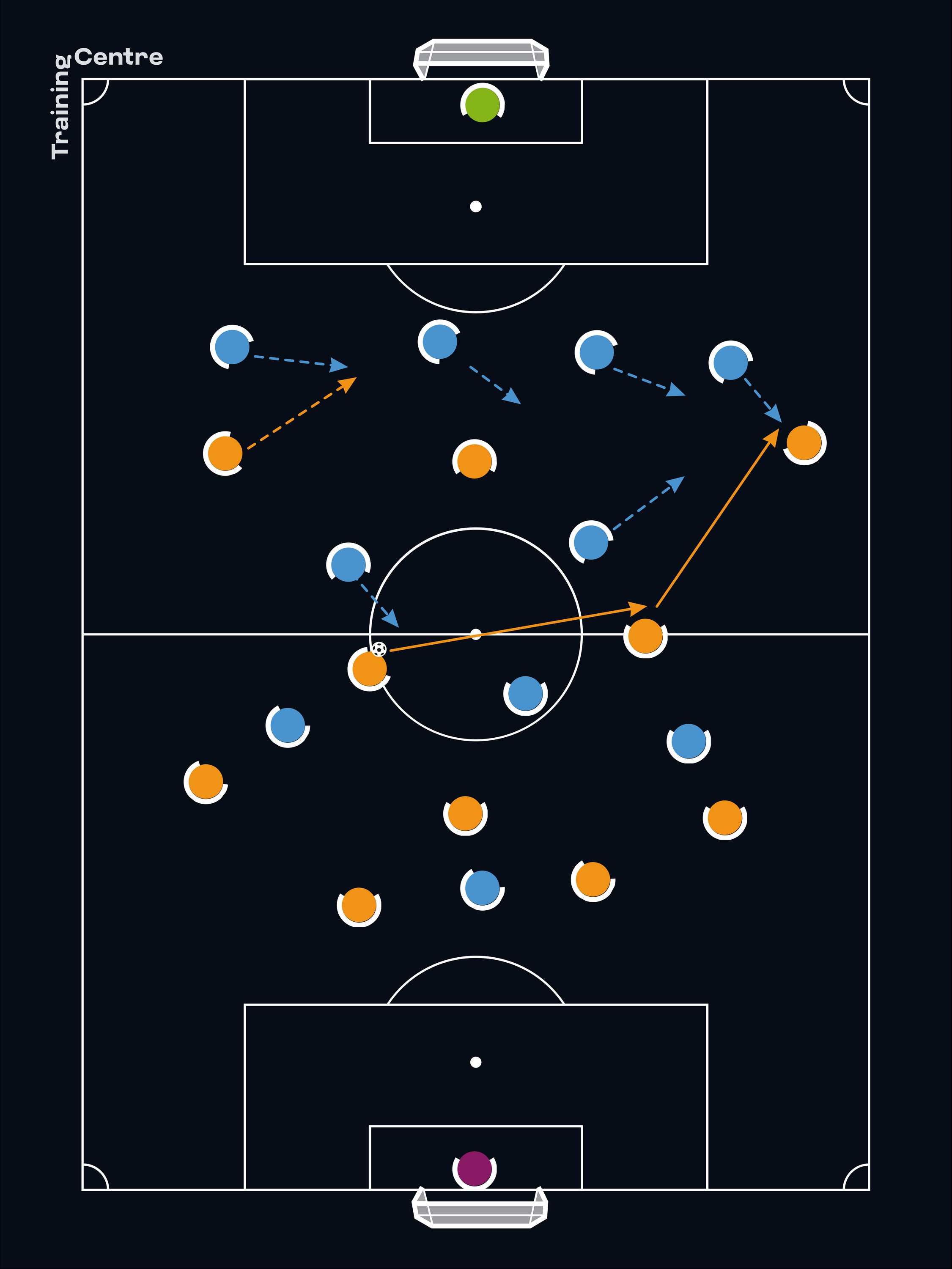
This session brings all of the defensive elements and principles seen in the previous drills together to offer the defending team a solid understanding of how to perform effectively as a unit. On the basis of the key principles, such as communication, togetherness, team spirit, organisation, shape and positioning, the defending team should be able to operate collectively as a fully functioning team.
-
Arrange 2 teams in an 11v11 game on a full pitch.
-
Set both teams up in a 4-3-3 formation.
-
Two teams contest an 11v11 game for a period of at least 10 minutes and focus on all of the defensive principles covered in the previous sessions.
-
The centre-forwards should press the centre-backs, with the other 2 attackers pressing in tandem and looking to shut off passes to the full-backs.
-
If the first defensive line is broken, the nearest midfielder needs to get across to the attacker, with the other midfielders following. The midfielder who is furthest from the play tucks in.
-
Ensure that the midfield line is compact, works together and that the midfielders are positioned in close proximity to their opposite numbers.
-
The centre-backs should play higher up the pitch and seek to get distance and height on their clearances.
-
The structure and restructuring of defensive units is important. When the goalkeeper goes long, the defending team should get back goal-side.
-
The full-backs should close the wide players down, with fellow defenders shifting across to support and deny the attackers space.
-
If a defender steps out of the defensive line to close attackers down, the defensive unit needs to move together.
-
Maintain a good distance and compactness between all units and pairings, with the midfielders supporting the attackers and so on.








